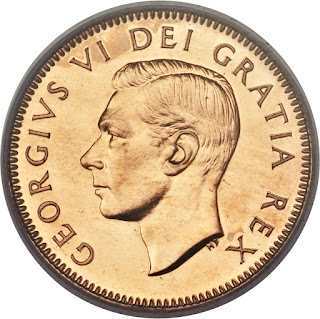Canadian Coins
Canada One Cent 1948 King George VI
Obverse: The portrait in left profile of George VI is surrounded with the inscription "GEORGIVS VI DEI GRATIA REX" (George VI, King by the grace of God) without IND IMP.
Lettering: GEORGIVS VI DEI GRATIA REX HP
Engraver: Thomas Humphrey Paget
Reverse: A maple leaf twig is surrounded with the facial value and the inscription "CANADA"
Lettering: 1 CENT 1948 K·G CANADA
Engraver: George Edward Kruger Gray
Edge: Plain
Years: 1948-1952
Value: 1 Cent
Metal: Bronze (.980 Cu, .005 Sn, .015 Zn)
Weight: 3.24 g
Diameter: 19.05 mm
Thickness: 1.65 mm
Shape: Round
Canadian Coins - King George VI
Canadian 25 Cent Coin 1948 Caribou Canadian 10 Cent Coin 1948 Bluenose
Canadian 5 Cents 1945 Victory Canadian 5 Cent Coin 1948 Beaver
Canadian 5 Cents 1945 Victory Canadian 5 Cent Coin 1948 Beaver
Canadian One Cent 1948 Maple Leaf Twig
A national symbol–the 1-cent coin
The maple leaf is a proud and distinctive Canadian symbol, appearing on all Canadian coins minted between Confederation and 1935. The modern 1-cent coin features two maple leaves on the same twig. The design, created by G.E. Kruger Gray, was first used in 1937 and has remained unchanged with one exception: in 1967, a rock dove designed by renowned Canadian artist Alex Colville appeared on the reverse to celebrate Canada's Centennial. Countess Grey struck the first 1-cent coin on January 2, 1908 at the official opening of the Ottawa branch of the Royal Mint (which became the Royal Canadian Mint in 1931).
1937 - 1966, 1968 - 1981, 1997 - present
The maple leaf twig (round coin)
In 1937, as part of an effort to modernize Canada's coins, G.E. Kruger-Gray created the maple leaf twig design. His initials appear on the right.
1942 - 1977
Composition: 98% copper, 0.5% tin, 1.5% zinc
Weight (g): 3.24
Diameter (mm): 19.05
Thickness (mm): 1.65
Mintages 1948 - 25,767,779

